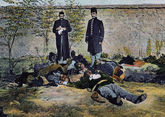The oil industry remains the leading sector of Azerbaijan's economy. In January-February of this year, Baku exported 5.78 million tons of oil. The rich deposits of oil were known long before the first oil boom. The US Energy and Сapital in the article Azerbaijan's White Oil writes about the history of oil production in Baku.
Edwin Drake and George Bissell are well known to be the first men in history to successfully use a drilling rig to produce crude oil near Titusville, Pennsylvania, in 1859. And this is often portrayed as the beginning of the modern oil era. But the fact is, fossil oil was well known and used by humans dating back thousands of years. Ancient manuscripts written well before the time of Christ refer to oil extraction from wells and its use in life, construction, medicine, and military. But there was one particular area in modern-day Azerbaijan that existed before oil discoveries were made in Saudi Arabia, Iran, or Kuwait.
Archaeological findings show human settlements around the Baku area dating back to the Stone Age. Mentions of fossil oil resources in the area go back almost as far as history itself. These vast resources attracted some of the most notable people in history, including people ranging from Alexander the Great to the Nobel brothers to the Rothschilds. Among the most notable mentions of oil were Ancient Greek writers who wrote about the campaigns of Alexander the Great surrounding the Caspian Sea.
They say Alexander went to the Baku region in the 4th century BC and found curious light sources surrounding the area where his army camped. The military leader investigated to find a yellow liquid being used as a fuel to create a torch. The natives called this light “Chirak.” And the fluid was known as “Naphatha,” which means, “liquid leaking from the ground.”
Don't confuse this with the modern naphtha (notice the spelling is different). Naphtha is a refined, nearly colorless hydrocarbon mixture. It's commonly used to make lighter fluids, camping fuels, cleaning solutions, and as paint medium and solvent. Naphatha was the term originally used to describe a natural, yellowish hydrocarbon mixture formed by natural gas condensates, petroleum distillates, and the distillation of coal tar and peat. Naphatha wasn't exactly white or clear, but it was whiter/clearer relative to other oil-type resources.
Much later, in the late 17th century, the Ottoman explorer Evliya Çelebi visited Baku and described the scale of Naphatha production. He wrote, “The Baku fortress was surrounded by 500 wells, from which white and black acid refined oil was produced.” This “white oil” described by Evliya Çelebi was the Naphatha previously found by Alexander the Great
Naphatha was used unrefined for several hundred years. And extraction was simply done by digging pits and collecting fossil oil that bubbled up from the ground. Explorer Evliya Çelebi also describes this. He wrote: By Allah's decree oil bubbles up out of the ground, but in the manner of hot springs, pools of water are formed with oil congealed on the surface like cream. Merchants wade into these pools and collect the oil in ladles and fill goatskins with it, these oil merchants then sell them in different regions. Later, more advanced drilling technologies were introduced, and it was processed into more refined products.
Under the direction of Russian Engineer F.A. Semenov, the first modern type of oil well was drilled around Baku in 1847.
And by 1850, the Baku region was producing 95% of all the world's oil and earned the moniker as the world's “Black Gold Capital.” It was no doubt the "OPEC" of its time. Baku's “Black Gold Capital” fame spread around and attracted none other than the Nobel brothers.
Robert and Ludvig Nobel began investing in oil production from the Baku area in the early 1870s. In 1873, they established the Nobel Brothers Oil Extracting Partnership. Three years later, Alfred Nobel went on to patent dynamite — something he would very famously regret later. Around that same time, the Rothschild family, of the major banking house in Paris, also became heavily involved in Baku oil trading. However, it wasn't until 1883 that the Rothschilds officially registered their firm, the Caspian-Black Sea Oil Industry and Trade Company. The Caspian-Black Sea Oil Industry and Trade Company focused on foreign markets and, by the end of the 1880s, had become the leading exporter of Russian kerosene. Naphatha was used as feedstock to make refined kerosene, which the Caspian-Black Sea Oil Industry and Trade Company bought and sold. In 1884, the company reported that it exported 2.4 million poods (an archaic measurement of weight equaling 16.38 kg). By 1889, it had increased exports to 30.0 million poods. This earned the Rothschilds the nickname “Kerosene Kings.”
Azerbaijan remains an important oil and gas producer today. But the country's kerosene industry is all but dead. Azerbaijan's energy industry is now looking to offshore development in the Caspian Sea. And some believe the total amount of oil that could be produced is worth trillions of dollars.










